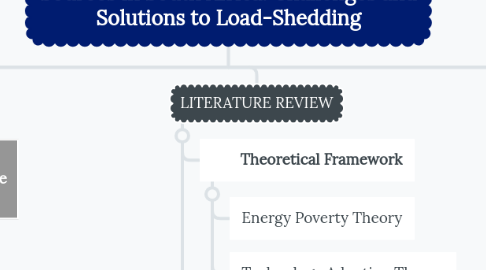
1. How to use this template
2. INTRODUCTION
2.1. Topic Introduction
2.1.1. Contextual background
2.1.2. Importance of intergration
2.1.3. Challenge overview
2.1.4. Thesis Statement
2.2. Context
2.2.1. Global Energy Transition
2.2.2. Differences between the two energy sources
2.2.3. Economic Considerations
2.2.4. Future Outlook
2.3. Problem Statement
2.3.1. Research Questions
2.3.1.1. What are the primary challenges faced by South African households due to load-shedding?
2.3.1.2. What alternative power or energy sources are South African households using to adapt to load-shedding?
2.3.1.3. How efficient are alternative sources of energy in converting raw into usable power
2.3.1.4. What government policies are in place to promote energy in conventional energy sources.
2.3.1.5. What are the most used energy alternatives used in townships?
2.3.1.6. Which factors influence consumer decisions to adopt alternative sources and the type of alternative energy sources they choose to adopt?
2.3.2. Hypothesis
2.3.3. Purpose
2.4. Aims
2.4.1. Educational
2.4.2. Raise Awareness
2.4.3. Finding Solutions to load shedding
2.4.4. Exploring the long-term implications of energy.
3. METHODOLOGY
3.1. In person interview, Questionnaires, Online Surveys
3.1.1. Flexible
3.1.2. Qualitative
3.2. Location: Doornfontein and CBD Gauteng
3.2.1. A significant urban area.
3.2.2. Now grown considered large in size
3.2.3. Not everyone have access to internet, generators. etc.
3.2.4. There is more senior people and average people residing for work.
3.2.5. This region is highly urbanized and experiences significant load-shedding impacts, providing a diverse sample for understanding household adaptations.
4. LITERATURE REVIEW
4.1. Theoretical Framework
4.1.1. Energy Poverty Theory
4.1.2. Technology Adoption Theory
4.1.3. Sustainable Livelihoods Framework
4.2. Discuss work produced by other Authors
4.2.1. Impact of Load-Shedding on Households
4.2.2. Alternative Energy Sources Used by Households
4.2.3. Socio-Economic Implications of Energy Insecurity
4.2.4. Comparative Analysis of Energy Policies and Practices
4.3. List of findings or Academic Sources
4.3.1. Bohlmann, J.A. and Inglesi-Lotz, R., (2018). Analysing the South African residential sector's energy profile. Renewable and Sustainable Energy Reviews, 96, pp.240-252. https://doi.org/10.1016/j.rser.2018.07.052
4.3.2. Popkova, E.G. and Sergi, B.S., (2021). Energy efficiency in leading emerging and developed countries. Energy, 221, p.119 https://doi.org/10.1016/j.energy.2020.119730
4.3.3. Smit, S., Musango, J.K. and Brent, A.C., (2019). Understanding electricity legitimacy dynamics in an urban informal settlement in South Africa: A Community Based System Dynamics approach. Energy for Sustainable Development, 49, pp.39-52. https://doi.org/10.1016/j.esd.2019.01.004
4.3.4. Todd, I. and McCauley, D., (2021). Assessing policy barriers to the energy transition in South Africa. Energy Policy, 158, p.112529. https://doi.org/10.1016/j.enpol.2021.112529
4.3.5. Zieba Falama, R., Ngangoum Welaji, F., Dadjé, A., Dumbrava, V., Djongyang, N., Salah, C.B. and Doka, S.Y., 2021. A solution to the problem of electrical load shedding using hybrid PV/Battery/Grid-Connected system: the case of households’ energy supply of the northern part of Cameroon. Energies, 14(10), p.2836. https://doi.org/10.3390/en1410283
4.4. Understanding
4.4.1. Global shifts torwards renewable energy sources
4.4.2. Motivations behind reducing reliance on conventional fossil fuel
4.4.3. Main chalenges
4.4.4. Strategies
5. METHODOLOGY AND FINDINGS
5.1. Introduction
5.2. Methodology
5.3. Data Collection
5.3.1. Figures
5.3.2. Maps
5.3.3. Tables
5.3.4. Graphs
5.4. Data Analysis
5.4.1. Quantitative Data Analysis
5.4.2. Qualitative Data Analysis
5.4.3. Economic Assessment
5.5. Discussions
5.5.1. Summary
5.5.2. Lesson learned and Best Practices
5.5.3. Limitations and Unanswered Questions.
5.6. Conclusions
5.6.1. Key points summary
